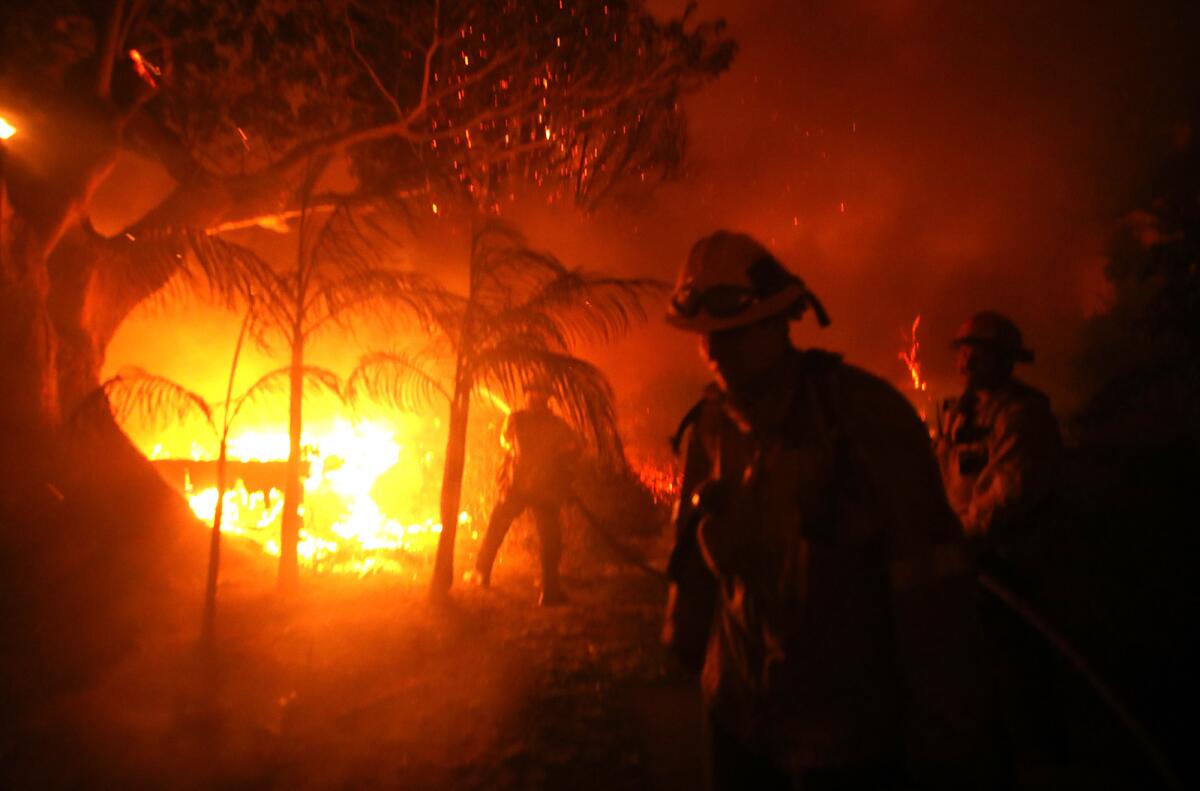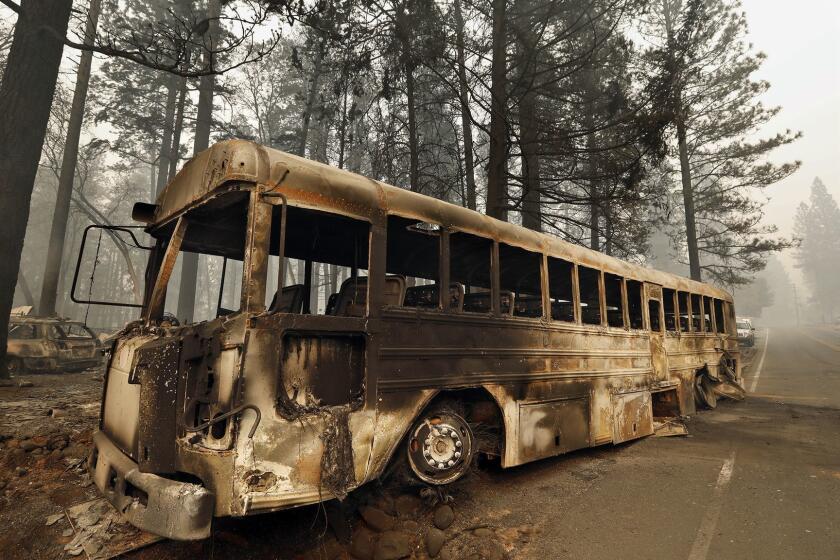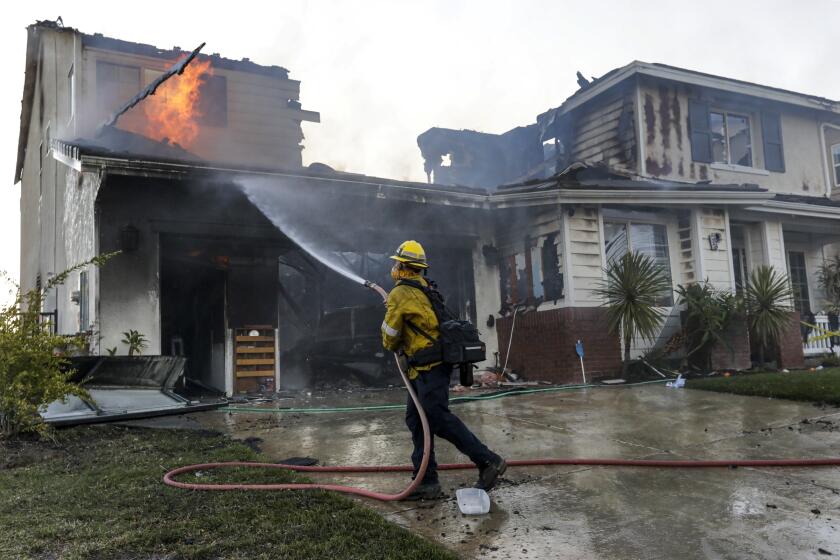New emergency evacuation guidelines won’t include ‘mandatory’ or ‘voluntary’ labels

- Share via
When the Cedar fire broke out near a populated area in Kern County in August 2016, fire officials issued a recommended evacuation order in an effort to get residents to quickly leave their homes.
The fire, which would eventually grow to more than 29,000 acres, continued on its path of destruction through the Sequoia National Forest over several days, eventually forcing people in neighboring Tulare County to flee. When the call came for those residents to leave, officials termed the order a “mandatory evacuation.”
The evacuations in both areas were immediately necessary, but the agencies used different language to communicate those requirements to residents, causing confusion among both the public and first responders, said Brian Marshall, a fire and rescue chief with the California Governor’s Office of Emergency Services. Marshall was the fire chief in Kern County during the blaze.
“You could just imagine how flustered people were starting out using Kern’s terminology and then, all of a sudden, the news is reporting mandatory evacuations,” Marshall said. “When you’re evacuating the public, that’s a high-stress time in their life. The last thing you want to do is confuse them with terminology.”
Similar scenarios unfolded across California in 2017 and 2018 as the state was ravaged by deadly debris flows and wildfires — disasters that frequently straddled multiple jurisdictions and sent first responders from various regions scrambling across the Golden State to lend a hand.
In May, after months of discussions with law enforcement and fire officials across California, the Governor’s Office of Emergency Services recommended standard evacuation terminology for cities and counties to use during an emergency.
Rather than issuing calls for “voluntary” or “mandatory” evacuations, state officials suggest that counties instead issue evacuation warnings and orders. An evacuation order notes an immediate threat to life and safety that requires people to leave their homes immediately. An evacuation warning signals a potential threat to life or property. Those who require additional time to evacuate or those with pets or livestock should prepare to leave their homes during an evacuation warning, under the state guidelines.
Leigh Bailey, 54, was awakened not by her phone, warning her about an incoming fire that would soon destroy her town, but by a neighbor pounding on her door.
At this point, the guidelines for a standardized approach to emergency communications remains voluntary. However, some municipalities across California, including Riverside, Santa Barbara and Ventura counties, have already adopted the new terminology.
While it’s not clear whether Los Angeles County plans to make any changes to its evacuation strategy, the city of Malibu — where the Woolsey fire charred a devastating path and destroyed more than 1,600 structures in 2018 — has committed to using the state-approved language.
In years past, Los Angeles County and city officials have struggled to effectively communicate with the public during emergencies.
During the Woolsey fire in 2018, Los Angeles County relied too heavily on social media and left many older residents in the dark about the approaching fire. A year later, a computer coding error prevented city staff from using emergency notification software to warn people of the Saddleridge fire.
Neither officials with the county nor the city of Los Angeles responded to requests for comment.
Executives in Ventura County, which was ravaged by massive back-to-back wildfires in 2017 and 2018, say they think having uniform terminology will help ease confusion among residents as well as first responders, who may be arriving to help during a disaster from hundreds of miles away.
“What makes sense in Ventura County should make sense everywhere else in California,” said Office of Emergency Services Director Patrick Maynard.
“It’s not uncommon to have incidents that traverse multiple counties. We saw that with the Thomas fire and the Woolsey fire. It’s important when neighboring counties are actively involved that consistent terminology be used to avoid confusion.”
While officials say the consistent terminology keeps fire officials and law enforcement agencies on the same page, experts note that it also may help the public better understand what it needs to do during an emergency when even a few minutes of delay can result in deadly outcomes.
It may even prompt residents to take the messages more seriously when they’re hearing it repeated from multiple sources in the same way. The opposite is also true, said Wändi Bruine de Bruin, a provost professor of public policy, psychology and behavioral science at USC.
“If the messages are inconsistent, then the interpretation might be different, and it leads to confusion,” Bruine de Bruin said. “It could lead people to pick and choose what messages they want to adhere to.”
Utility power outages are complicating evacuation efforts as wildfires rage in Northern and Southern California.
After the Thomas fire ravaged Santa Barbara County in late 2017 and a deadly mudslide swept through Montecito in early 2018, public officials there announced they’d changed their phrasing for evacuation orders to eliminate the use of the word “voluntary.” Instead, they replaced it with “warning,” which is closer in step with National Weather Service terminology and the state recommendations that later followed.
The mudslide, which killed 23 people and destroyed 130 homes in Montecito, revealed several deficiencies in the county’s planning procedures, including how they handled evacuation warnings.
In the days before the slide, officials released conflicting evacuation instructions that left some hard-hit neighborhoods out of the warning zone. Some residents who had been on edge for weeks during the Thomas fire were fatigued by the constant messaging about possible evacuations and hesitated leaving their homes before the storm.
The situation prompted authorities to rethink their evacuation strategy, officials say.
Santa Barbara’s frequent draw as a destination for weekend getaways for Southern Californians also adds to the importance of having uniform messaging in evacuation orders, said Kelly Hubbard, director of Santa Barbara County’s Office of Emergency Management.
“We want them to get and understand the same terminology they would get in their home county,” she said.
Times staff writer Joseph Serna contributed to this report.
More to Read
Sign up for Essential California
The most important California stories and recommendations in your inbox every morning.
You may occasionally receive promotional content from the Los Angeles Times.













